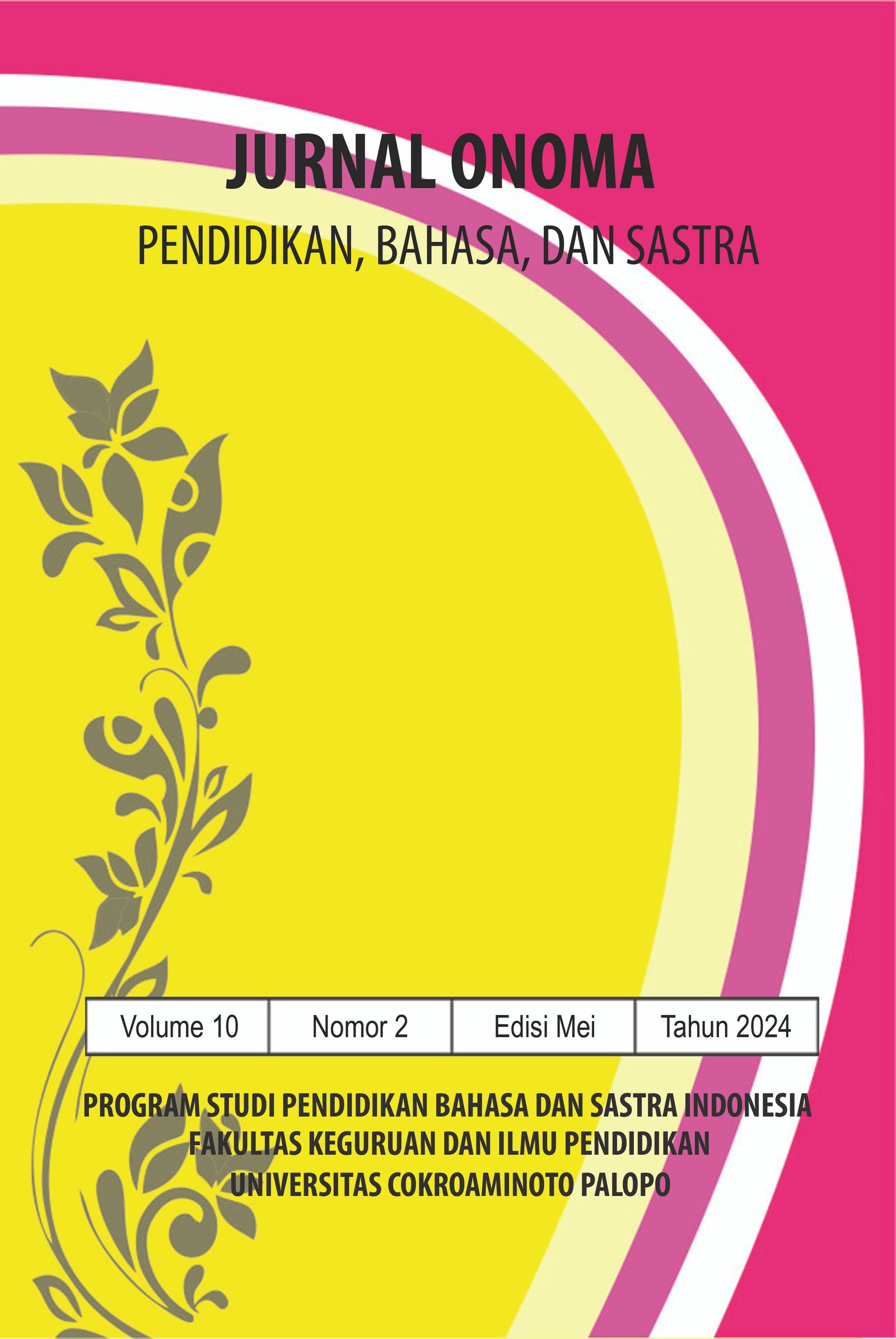Character Analysis Ability of M. Night Shyamalan Split Translation Film Characters in Indonesian EFL Students
https://doi.org/10.30605/onoma.v10i2.3196
Keywords:
Analytical skills, Character, Split's subtitled filmAbstract
The background of this research is to identify or determine the ability to analyze the character analysis of the characters in the film translation Split by M. Night Shymalayan in Semester VI Students of Indonesian Language Education Faculty of Teacher Training and Education in the 2022/2023 academic year. The number of samples in this study is 27 people, class B consisted of 24 girls and 6 boys. Data collection was used, namely test sheets and observation sheets. Then, the data analysis used in this study was the Quantitative Description technique, because the data studied were in the form of technical figures for student learning outcomes by identifying or determining the characters in the Split translation film by M. Night Shymalayan by using a certain formula. The results showed that the students' ability to analyze the characters of M. Night Shymalayan's Split translation film character in sixth-semester students of Indonesian language education experienced differences in every aspect that was assessed. The results of data analysis show that the average score obtained or achieved by class B students in the sixth semester of Indonesian language education obtained an average score of 69.26% with a total percentage of 2.57% in the good category. This means that the split translation film media helps students to identify the character analysis skills of M. Night Shymalayan's split translation film characters.
Downloads
References
Cahyono, S. P., & Setyaningsih, N. (2014). Teaching Recount through Reading to Learn Programme: A Classroom Action Research. English in the Professional World: Issues of the teaching of English language and culture in the professional world, 30.
Condinho Bravo, M. D. C. (2008). Putting the reader in the picture. Screen translation and foreign-language learning. Universitat Rovira i Virgili.
Huda, M. H., Ghazali, A. S., Siswanto, W., & Hasanah, M. (2019). Cognitive Level of Characters in the Indonesian Novel As a Source of Learning. Journal for the Education of Gifted Young Scientists, 7(4), 931-952.
Ismail, I. (2020). Converting a Story from Students’ Own Language in English to Increase Speaking Ability.
Kaharuddin, K., & Ismail, I. (2022). The use of ‘I-Do’methodology in integrating moral characters into the development of ELT materials for transactional speaking skills. Linguistics and Culture Review, 6(1), 1-29.
Kang, S. Y. (2012). Individual differences in language acquisition: personality traits and language learning strategies of Korean university students studying English as a foreign language (Doctoral dissertation, Indiana State University).
Muhith, A. Evaluating The Quality of Three English Textbook Published by Gontor Press (A Content Analysis on EFL Textbook for Islamic Boarding School of Daarul Falah Serang Banten) (Master's thesis, Jakarta: FITK UIN Syarif Hidayatullah Jakarta).
Muthmainnah, A. R., Atmowardoyo, H., Salija, K., & Asrifan, A. (2020). Literary Work as Teaching Materials: A Study of Students and Lecturers Needs Analysis. Solid State Technology, 63(5), 394-407.
Pasassung, N. (2003). Teaching English in an" acquisition-poor environment": An ethnographic example of a remote Indonesian EFL classroom. Department of Linguistics, Faculty of Arts, University of Sydney.
Pujiantik, S. (2018). Translation Ability of The Fourth Semester Students in English Language Education of FKIP UIR (Doctoral dissertation, Universitas Islam Riau).
Rochmawati, D. (2011). Shift To The Future: The Prospects of Enhancing English Proficiency And Personal Development Through Humorous Texts. "Future Education in Global Challenges, 71.
Srour, B. A. A. (2021). The Effect of Authentic Movies on Al-Aqsa University EFL Students' Performance in Pronunciation and Listening Comprehension (An Electronic Study in Light of COVID-19 Pandemic) (Doctoral dissertation, جامعة الاقصي).
Supatmiwati, D. (2013, January). Characters of William Shakespeare in translation on Shakespeare in love subtitling: A systemic functional linguistic approach. In International Conference on Education and Language (ICEL) (Vol. 1).
Downloads
Published
How to Cite
License
In submitting the manuscript to the journal, the authors certify that:
- They are authorized by their co-authors to enter into these arrangements.
- The work described has not been formally published before, except in the form of an abstract or as part of a published lecture, review, thesis, or overlay journal.
- That it is not under consideration for publication elsewhere,
- That its publication has been approved by all the author(s) and by the responsible authorities – tacitly or explicitly – of the institutes where the work has been carried out.
- They secure the right to reproduce any material that has already been published or copyrighted elsewhere.
- They agree to the following license and copyright agreement.
License and Copyright Agreement
Authors who publish with Onoma Journal: Education, Languages??, and Literature agree to the following terms:
- Authors retain copyright and grant the journal right of first publication with the work simultaneously licensed under Creative Commons Attribution License (CC BY 4.0) that allows others to share the work with an acknowledgment of the work's authorship and initial publication in this journal.
- Authors are able to enter into separate, additional contractual arrangements for the non-exclusive distribution of the journal's published version of the work (e.g., post it to an institutional repository or publish it in a book), with an acknowledgment of its initial publication in this journal.
- Authors are permitted and encouraged to post their work online (e.g., in institutional repositories or on their website) prior to and during the submission process, as it can lead to productive exchanges, as well as earlier and greater citation of published work.

















